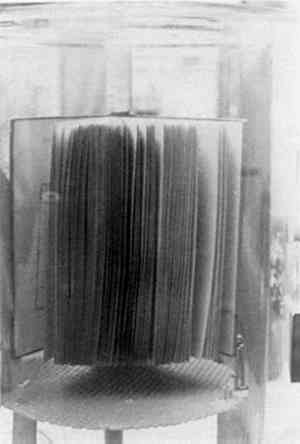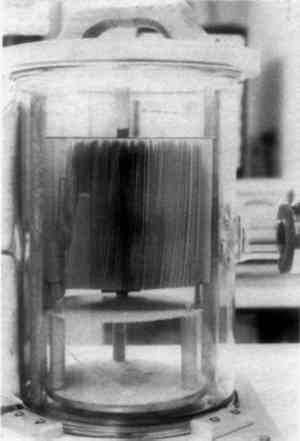VAPOR PHASE CONSOLIDATION OF BOOKS WITH THE PARYLENE POLYMERSBruce J. Humphrey
4 RESPONSE OF A BOUND VOLUME TO VACUUMTHE FIRST STEP in this investigation involved placing a book in the vacuum chamber to determine what effect this would have and to determine if it would be possible to arrange the individual pages to allow adequate penetration of the parylene molecules. Some “interleaf spacing” would have to be maintained as parylene will not penetrate a closed book. For this test, the book was placed on a platform in an upright position and opened about 180� so that the binding supported the book and the leaves were free to move within the arc created by the book covers (Fig. 2). An attempt was then made to arrange the leaves more or less equidistant from one another. This became a frustrating task and it was decided to simply place the mounted book in the chamber and evacuate the air to see what immediate effects the vacuum would have on the book. This was done, and it was immediately discovered that the leaves of a book will automatically arrange themselves in a fanlike fashion as the air is evacuated (Fig. 3). The cause of this phenomenon is thought to be outgassing of air and moisture as the chamber pressure drops. The “fanning” phenomenon occurs generally in the first 30–45 seconds of the evacuation cycle. It was this unusual and unexpected phenomenon that made it possible to attempt the “in situ” polymerization of parylene in books. A book when closed or with “bunched” leaves will not allow the parylene vapors to adequately penetrate into the book.
Pumping was continued until a suitable pressure for deposition was reached and then the book was returned to atmospheric pressure and removed from the chamber. The result was some minor warpage of the pages and cover due to moisture loss. The book was then left to equilibrate at ambient humidity in the lab which allowed the book to return to its normal pre-vacuum condition. The amount of Once it was determined that the leaves of a book would arrange themselves to facilitate penetration of the gaseous phase of the polymer, actual attempts at “in situ” polymerization could be considered. |

